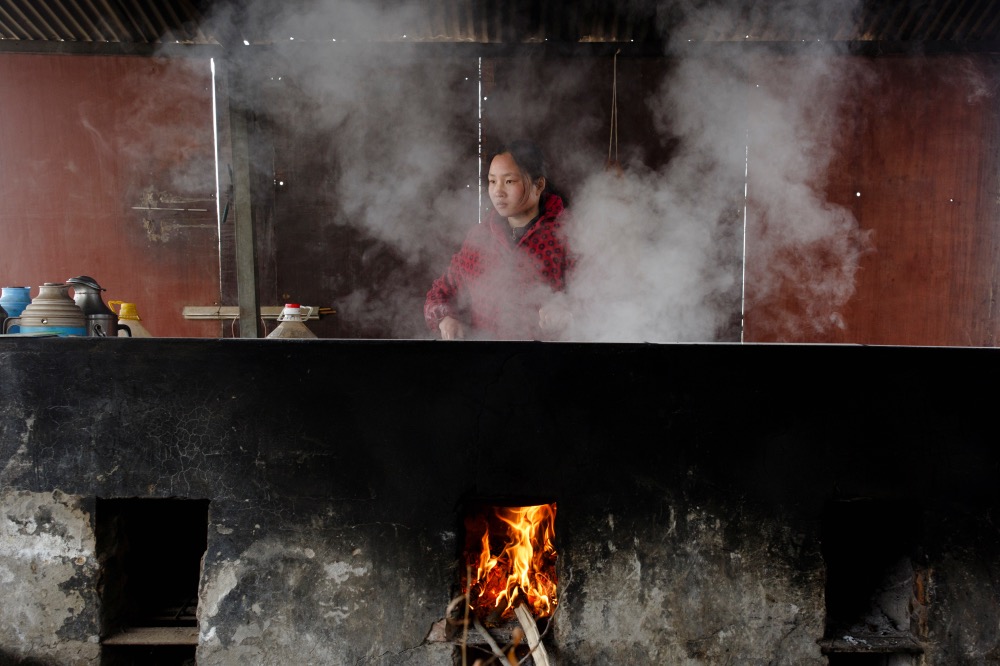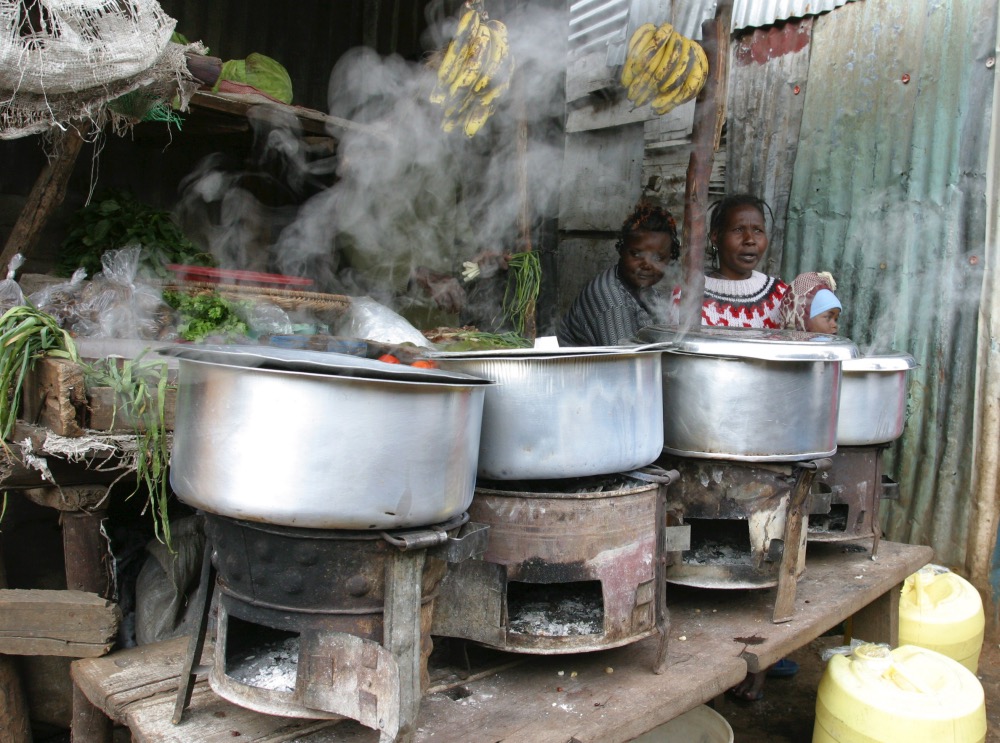
MEGAN ROWLING, of the Thomson Reuters Foundation, reports on how a failure to provide access to clean, safe and affordable ways of cooking is costing the global economy trillions a year…
Barcelona, Spain
Thomson Reuters Foundation
A global failure to provide about four billion people – half the world’s population – with access to clean, safe and affordable ways of cooking is costing $US2.4 trillion a year in damage to health, the climate and local economies, new figures show.
A report released by the World Bank and its partners this week said women bear the brunt of preparing food using harmful and polluting fuels – a blindspot for governments and business, despite a global goal to provide clean cooking for all by 2030.

Jiejie Li, the wife of fisherman Sun Lianxi prepares food on a wood stove in their makeshift dwelling at the Yellow River embankment on the northern outskirts of Zhengzhou, Henan province, China, on 21st February, 2019. PICTURE: Reuters/Thomas Peter/File photo.
The bulk of the cost of dirty cooking – $US1.4 trillion per year – comes from the health impacts of using smoky, high-emitting fuels such as wood, kerosene, charcoal and dung, it estimated.
“Women bear a disproportionate share of this cost in the form of poor health and safety, as well as lost productivity,” said Makhtar Diop, World Bank vice president for infrastructure.
“Women bear a disproportionate share of this cost in the form of poor health and safety, as well as lost productivity.”
– Makhtar Diop, World Bank vice president for infrastructure.
The toll on women could rise during the coronavirus pandemic, he warned, as household air pollution from dirty fuels and stoves could make them more susceptible to COVID-19 and other respiratory diseases.
According to the World Health Organization, illnesses linked to indoor air pollution from cooking on open fires and inefficient stoves cause nearly four million premature deaths each year, mainly among women and children.
Previous international calculations put the number of people worldwide cooking with dirty fuels at close to three billion.
But World Bank researchers said that figure overlooked the fact that some families had access to cleaner methods such as gas yet still mainly used traditional fuels like charcoal.
Sub-Saharan Africa has the smallest share of people using modern sources of energy for cooking, at 10 per cent, followed by 21 per cent in Southeast Asia and 27 per cent in South Asia, it said.
Its new approach measures not just the emissions and efficiency of stoves, but also the impact of cooking methods on health and whether they are convenient, safe and affordable.
The World Bank and other clean cooking experts say providing poor households with more efficient stoves that burn less of the same old fuels with fewer fumes is not sufficient.
Global attention has now shifted to helping people adopt new sources of energy, such as gas, biomass pellets and electricity.
Ed Brown, a professor at Britain’s Loughborough University who is research director for the “Modern Energy Cooking Services” partnership, said it was “untenable” that half the world’s population lacked access to clean cooking fuels.
But that also presented huge opportunities, especially with surging interest in electric cooking, he said.
MECS, for instance, has been working with a Kenyan company called BURN Manufacturing to design and produce an electric pressure cooker for the local market – and is testing such cookers in eight countries.
On a larger scale, Nepal is one government hoping to shift its citizens to electric cooking as it works to provide electricity access across the entire country by 2022-23.
Still, Hara Raj Neupane of the Nepal Electricity Authority told an online event his agency would need to overcome problems including unreliable supply and high tariffs for domestic consumers to enable them to switch successfully.
Brown said biogas was another promising area that could help ease environmental concerns around the growing promotion of LPG – a fossil fuel – as a cleaner cooking solution, particularly for urban households in developing nations.
“There are tremendous opportunities out there for the generation of bio-LPG from municipal waste, agricultural residues and so on,” he said.

Women sit next to their cooking stoves at the sprawling Kibera slums in Kenya’s capital Nairobi, on 8th June, 2009. PICTURE: Reuters/Noor Khamis/File photo.
Companies from Vietnam to Egypt are installing equipment on farms to produce biogas from animal dung or capturing methane from city landfills, which reduces climate-harming emissions and can be a clean substitute for conventional gas.
The World Bank report emphasised that funding for clean cooking efforts is falling far short, stagnating in the range of tens of millions of dollars per year when billions are needed to fix the problem.
It estimated that $US150 billion is required annually to reach universal access to cooking services using modern energy by 2030.
Dymphna van der Lans, CEO of the UN-backed nonprofit Clean Cooking Alliance, said while that sum seemed large, the cost of inaction would be 16 times greater over the decade.
“Meeting this massive investment gap will be challenging – but it is clear that it also will be money well spent, as well as millions of lives saved,” she said in prepared remarks.
World Bank officials noted the approval this month of its largest clean cooking operation in Africa, which will provide $US20 million for Rwanda under the first project financed by the recently launched Clean Cooking Fund.
The project targets more than two million people, and will leverage an additional $US30 million in public and private sector investments to develop a sustainable market for affordable clean cooking solutions in Rwanda.
It is part of a larger package of $US150 million in energy financing which also aims to improve Rwanda’s electricity services – a combined approach that officials said would be key to cracking the shortage of funding for clean cooking.
Yet while the outlook for the neglected sector is improving, some sounded a note of caution over the impacts of the pandemic.
Paul Mbuthi, deputy director of renewable energy at Kenya’s Ministry of Energy, said disruptions to the supply chain and financial pressure on consumers may have pushed some back to old, dirty ways of cooking.
Clean cooking entrepreneurs needed support to build their businesses back up, he said, noting that he hoped the government would include such assistance in its second round of economic stimulus.
Van der Lans of the Clean Cooking Alliance said COVID-19 had “severely disrupted” the progress of companies, researchers, investors and others working to advance clean cooking.
Governments could step in by designating clean cooking as an essential service, lowering costs for consumers by reducing equipment and energy tariffs and helping companies overcome supply chain disruptions, she added.
“Governments can and must make clean cooking part of their pandemic response and recovery plans,” she said.





